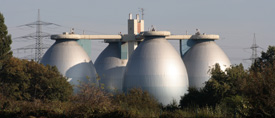Ozone and biotreatment technology for wastewater
The CADOX project focussed on treating water contaminated with chlorinated solvents and pesticides, which have been identified as being potentially harmful to human health. Ozone and biotreatment were employed together to decontaminate water containing a range of pesticides. Tests were initially carried out on synthetic effluent in order to optimise the conditions used for ozone. The results were then expanded to a full-scale industrial pilot plant. The plant allowed researchers to treat different effluent flows and to test different concentrations of ozone. Researchers produced ozone from dry oxygen, providing a low gas flow in high concentrations. The gas was injected into two contact columns in series, with each column using a different mode of ozone transfer. In the first contact column a small quantity of ozone was introduced via a hydroinjector. In order to facilitate contact between the effluent and ozone gas, a recirculation pump drew off gas from the second contact column via a second hydroinjector. The second contact column used conventional ozone transfer by employing stainless steel porous diffusers. High ozone levels and the use of dry oxygen meant that conventional PVC porous diffusers were unsuitable. Any ozone contained in the vent gas leaving the first column was eliminated by a thermocatalytic ozone destroyer. Ozone, coupled with biological treatment, is one of the cleanest technologies for treating contaminated water as it produces no sludge, nor harmful products. The use of this emerging technology will help the European water industry to become more sustainable and competitive. This in turn will enable European industry to achieve a greater share of the global market for cost-effective industrial water technology.







